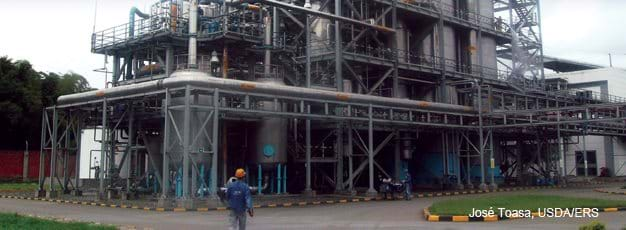Colombia Becoming a New Ethanol Player

The U.S. and Brazil are the Western Hemisphere’s leading ethanol producers. During the past few years, however, Colombia has emerged as the second largest ethanol producer in Latin America. Colombia’s energy self-sufficient production process uses byproducts from ethanol processing such as bagasse, the product remaining after crushing and extracting the juice from the cane, and vinasse, the product generated after the distillation of fermented molasses.
Colombia began producing sugarcane-based ethanol in October 2005 and produced an average of 277,380 gallons per day in 2007, or less than 1.5 percent of Brazil’s current daily production. Colombia’s cane is grown in the Cauca Valley, located in the country’s central southwest. The Cauca Valley has about 988,000 acres of crop area, of which 518,000 are sugar plantations, including 101,000 acres for ethanol production.
Colombian ethanol plants, like most in Brazil, use bagasse as a power source. With this feedstock, the ethanol plants not only generate all of the energy they need for producing ethanol, but also are able to sell surplus energy to the national electric grid. An equivalent of 1 percent of Colombia’s annual electricity consumption, or 90 megawatts (MW), is produced from bagasse, of which 15 MW are sold to the national electricity network. The industry’s potential, however, is 230 MW, or about 2.5 percent of Colombia’s electricity consumption.
In addition, due to the vinasse treatment, the process used by Colombia’s ethanol producers appears to benefit the environment. This process uses a technology imported from India and enables ethanol producers to comply with the environmental regulations set by Colombia’s government. Vinasse can pose water or soil pollution hazards if not properly disposed of or further processed. The production process used in Colombia generates low volumes of vinasse rich in phosphorous, magnesium, and potassium, which can be further processed into fertilizer.
About 70 percent of all gasoline sold in Colombia is mixed with 10-percent ethanol, and cane-based ethanol production is expanding. Colombia has the potential to expand sugarcane production to approximately 3 million acres. By 2010, if all existing projects evolve as planned, Colombia will produce about 1 million gallons per day, up 218 percent from 2007. If the U.S. Congress approves the proposed U.S.-Colombia Trade Promotion Agreement, Colombia could permanently ship its ethanol surplus to the United States duty free and not be subject to any quota. Because the cane for future production will come from new crops and unused land, Colombia’s agricultural exports and food security should not be affected by expanding ethanol output.
Encouraged by domestic success, Colombians are beginning to invest in ethanol production in Peru and Brazil. The Colombian government, private sector, and multilateral organizations, such as the Inter-American Development Bank, are developing Colombia’s potential in order to expand the country’s role in the Western Hemisphere biofuels industry.
Colombia: A New Ethanol Producer on the Rise?, by Jose Toasa, USDA, Economic Research Service, January 2009
Bioenergy, by Steven Ramsey, USDA, Economic Research Service, September 2022
Sugar & Sweeteners, by Vidalina Abadam, USDA, Economic Research Service, July 2023

